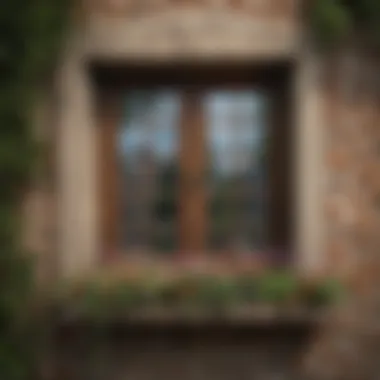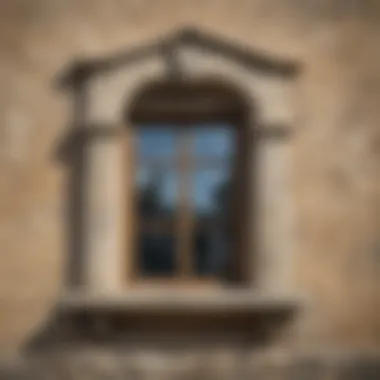Exploring Village Windows: Architecture and Culture


Intro
The examination of windows in rural architecture holds a significant place in understanding the socio-cultural fabric of village life. Windows do not merely serve a functional purpose. Rather, they act as a transitional element between the inside and outside, reflecting both architectural styles and the influence of cultural narratives. This article aims to dissect the significance of windows in villages, charting the interplay between architectural choices and the environments in which they are situated.
Exploring the styles of windows across various regions reveals much about the communities that inhabit them. Each window carries traces of local history, climate adaptation, and aesthetic preference. By analyzing these elements, we uncover how windows embody the essence of a village’s identity and heritage.
Socio-Economic Context
Understanding the socio-economic factors that influence architectural features is crucial. In many cases, the design and material of windows relate directly to the currents of local economy, labor availability, and even agricultural practices. For instance, in coastal areas, larger windows may be designed to maximize ventilation against humidity. In contrast, villages in colder climates often employ smaller, double-glazed windows to retain heat.
Cultural Insights
Windows also represent a cultural lens. They can tell stories of tradition, superstition, and social norms. Where shutters are adorned with intricate carvings, it speaks of local artistry and pride. In contrast, simpler designs may reveal a utilitarian approach molded by necessity rather than aesthetic considerations.
"Windows are not just openings; they are expressions of who we are as communities and individuals, reflecting our shared history and place within the world."
As globalization alters rural landscapes, the window’s role has evolved. Contemporary designs often clash with traditional forms, raising questions about identity preservation versus modernization. By diving deep into the architectural significance and cultural narratives surrounding village windows, this article seeks to provide a nuanced understanding of how these elements enrich the tapestry of rural life.
Prelims to Village Windows
Village windows serve as more than just mere openings in walls; they are significant structural components that reflect both the aesthetic and functional nature of rural architecture. In this section, we will explore the various dimensions of village windows, focusing on their definition, historical significance, and contextual relevance today.
Understanding village windows involves a closer inspection of their designs, materials, and the cultural philosophies that they embody. They often display unique characteristics influenced by the local environment and traditions, suggesting insights into the lives of the people who inhabit these villages. The purpose of this exploration is to highlight their importance not only as architectural features but also as carriers of stories and cultural identity.
In summary, the significance of village windows extends beyond their physical form. They offer valuable information about the socio-economic conditions, evolving lifestyles, and traditions prevalent within rural settings. As we delve further into their definition and historical context, we will unravel how these architectural elements contribute to a broader understanding of village life.
Defining Village Windows
Village windows can be defined as openings that allow light and air in while maintaining a connection between indoor and outdoor spaces. They often vary widely in design, size, and shape, influenced by specific cultural and climatic conditions of different regions. For instance, a traditional wooden frame may be prevalent in one area, while another may showcase intricate stonework.
These windows are often framed by elements like shutters, grills, or decorative moldings, enhancing their architectural appeal. They serve practical functions such as ventilation, insulation, and aesthetics, which ultimately enhance the quality of life for residents. Beyond these functional aspects, they also offer a glimpse into the values and priorities of the society that created them.
In addition, village windows can embody rich symbolism. For many communities, they represent hospitality and openness, reflecting the spirit of welcoming neighbors and visitors alike. This melding of practicality and symbolism highlights how deeply interwoven these elements are in the cultural fabric of village life.
Historical Context of Village Architecture
The architectural evolution of village windows cannot be disconnected from the socio-historical factors influencing rural designs. Historically, village architecture has developed in response to local resources, climate, and cultural practices. In areas where timber was abundant, wooden windows became the norm, while stone regions featured sturdier designs.
As society moved through different historical periods, these influences shaped the evolving styles of windows. For example, during the medieval times, simple, small windows served the practical purpose of safety and climate control. In contrast, the Renaissance period introduced larger and more ornately decorated window designs, reflecting a shift towards beauty and artistic expression.
Moreover, various socio-economic factors contributed to these changes. The rise of trade and economics led to increased prosperity, which allowed for more elaborate designs. Throughout history, village windows have mirrored shifts in daily life, traditions, and cultural interactions. Their transformative journey illustrates the complexity of architectural practice and the rich narrative they tell regarding regional identity and community values.
"Windows, in their essence, are a reflection of the lives led inside and outside the village walls."
The Aesthetic Appeal of Village Windows


The aesthetic appeal of village windows goes beyond mere decoration. These architectural elements encapsulate the charm and character of rural life. They can reflect the historical narratives, local traditions, and stylistic choices that shape a village's identity. A well-crafted window can enhance the beauty of a home and serve as a cultural artifact that speaks to wider societal values and environmental contexts.
Village windows also play a significant role in the visual cohesion of village architecture. Their designs can tie together various structures, creating a sense of unity amidst diversity. The color palettes, shapes, and sizes often echo the natural surroundings, which can be a factor in attracting both residents and tourists. Understanding this aesthetic significance is crucial when exploring the broader themes of architectural reflections and cultural insights.
Design Variations and Styles
The design of village windows reveals a multitude of variations and styles, shaped by historical context, available materials, and local customs. In European villages, for instance, windows may feature intricate woodwork or decorative elements like shutters. These often serve as an aesthetic hedge against harsh weather and contribute to a cozy atmosphere.
In contrast, Asian village windows may incorporate sliding designs that reflect a harmonious relationship with nature. Bamboo and rice paper are common materials, symbolizing simplicity and functionality. The differences in design are not merely decorative; they indicate the climate, cultural practices, and the lifestyle of the inhabitants.
In North America, window styles often reflect colonial influences adapted over time. Characteristics can range from large-pane ledges that allow sunlight to flood the interior to more compact designs that prioritize insulation and energy efficiency.
Material Choices and Their Implications
Material choices for village windows significantly affect their aesthetic as well as practical properties. Wood is the most prevalent material in many regions, offering warmth and a traditional look. However, it requires careful maintenance to withstand weather changes, particularly in humid or snowy climates.
Metal frames, often seen in more modern adaptations, provide durability and a sleek appearance. Yet, they can create a disparity in architectural style if not used thoughtfully, detracting from the rustic charm that defines many village settings.
Glass types also play a crucial role. In some areas, frosted or stained glass is used to add decorative flair while providing privacy. Clear glass, however, serves a practical function by maximizing light and views, which is highly valued in rural landscapes. As such, the choice of materials is both an artistic decision and a reflection of local environmental factors and practical needs.
The aesthetic considerations for village windows are interwoven with material choices and cultural identities, leading to structures that resonate with both beauty and purpose.
Functional Roles of Windows in Rural Homes
Windows play a crucial role in the architecture of rural homes, serving both practical and cultural functions. Their significance extends beyond mere aesthetics. They influence how families interact with their environment and can shape community dynamics. Through the lens of functionality, village windows reveal insights into the design ethos of a locale. Each window serves as an architectural interface between the inside and outside worlds, making them indispensable in rural lifestyle.
Natural Light and Ventilation
One of the primary functions of windows is to provide natural light. Sunlight not only enhances the aesthetic appeal of interior spaces but also supports mental well-being. In villages, large windows are often strategically placed to capture morning light while avoiding harsh glare during midday. This thoughtfulness in design optimizes illumination throughout the day.
In addition to light, windows facilitate natural ventilation. Proper airflow is essential in rural areas where air conditioning may not be available. By opening windows, residents can regulate indoor temperatures, especially during hot months. Cross-ventilation created by opposite windows helps maintain a fresh and comfortable environment. This natural heating and cooling method is both energy-efficient and sustainable, aligning with eco-friendly practices in rural construction.
Security and Protection Mechanisms
Beyond their role in light and air regulation, windows in rural homes must also address security concerns and protection against the elements. Strong window frames and durable glass are essential for safeguarding inhabitants and their belongings. Many rural designs include features like shutters or bars, reflecting the community’s emphasis on safety.
Windows also serve as barriers against weather. Double-glazing or thick wooden frames can insulate homes, keeping occupants warm during cold seasons. Such protection enhances the longevity of the structure, ensuring it withstands harsh weather conditions. Additionally, a window's height and orientation can deter intruders, allowing households to maintain a sense of security.
"Windows are not just openings in walls; they are gateways to light, air, and security, shaping how individuals engage with their surroundings."
In summary, understanding the functional roles of windows in rural homes provides valuable insights into local customs and architectural choices. The architectural design is often a reflection of the needs and aspirations of the community, where each window contributes significantly to both the physical and cultural landscape.
Cultural Significance of Village Windows
Village windows are not merely functional elements in architecture; they serve as vital cultural markers that express local identity and heritage. Their design, placement, and ornamentation reflect centuries of history, tradition, and the unique socio-economic conditions of a particular area. When examining village windows, one must consider how they encapsulate local stories, values, and even collective memories.


The architectural style and construction material of village windows often align with the region's available resources and climatic conditions. For example, wooden frames may dominate in forested areas, while stone or mud may prevail in regions with a scarcity of timber. This not only signifies the resourcefulness of local craftsmen but also mirrors how communities have adapted to their environments over generations. As a result, each village window offers insights into the lifestyle and identity of its inhabitants, making it a key focal point for anyone studying regional cultures.
Windows as a Reflection of Local Identity
The design of windows in village homes often showcases distinctive local styles, which vary significantly from one region to another. In Europe, brightly painted shutters may evoke a sense of festivity, while in parts of Asia, intricate lattice work can signify tradition and craftsmanship. These variations are essential as they embody the particular aesthetics and values of a community.
For example, in Mediterranean villages, arched windows are a common sight. They not only provide ventilation but also align with historical influences from periods of conquest and trade. On the other hand, in Scandinavian regions, large glass panels are a characteristic feature, prioritizing natural light and views of the surrounding landscapes.
- The architectural differences impact the way residents interact with their environment.
- Windows provide glimpses into the interior lives of families and even foster community interactions in rural settings, which often rely on strong interpersonal ties.
Thus, the window acts as a lens that reveals much about local identity and collective experience.
Rituals and Traditions Associated with Windows
Windows in village architecture often serve as sites for various cultural rituals and practices, forging connections between the home and the greater community. Traditionally, specific events such as harvests or festivals would be celebrated openly through windows, allowing villagers to participate in the festivities from their homes.
In many cultures, windows hold symbolic meanings, often related to hospitality and openness. In some instances, the act of leaving a window open during community gatherings signifies an invitation or welcome to neighbors and friends. Moreover, certain windows may be adorned with seasonal decorations that reflect local traditions, enhancing their significance.
- Wedding ceremonies: In various cultures, windows play a role during weddings, where family members gather to celebrate with music and songs while guests take part from outside.
- Funerals: In some traditions, mourning practices may include placing photographs at windows as a way for the spirits of the departed to find their way home.
These rituals and traditions surrounding village windows highlight their importance beyond mere functionality, marking them as integral parts of communal life that sustain cultural identities across generations.
"Windows not only illuminate a home but also reflect its soul, serving as a bridge between the exterior world and the intimate space of family life."
Overall, the cultural significance of village windows is profound. They encapsulate local identity, showcase architectural diversity, and serve as ongoing sites of cultural practices. Studying these elements provides a deeper understanding of how communities view themselves and share their identities with the broader world.
Influence of Modernization on Village Windows
The influence of modernization on village windows encapsulates a critical intersection of technological advancements and architectural traditions. This topic not only highlights how traditional designs have been adapted to meet contemporary needs but also emphasizes the significance of preserving cultural heritage amidst rapid changes. As villages evolve, understanding this transformation can reveal how local identities are maintained or altered, and how these changes affect community life.
Shifts in Architectural Trends
Modernization has brought significant shifts in architectural trends across rural landscapes. Contemporary materials like glass and aluminum are increasingly replacing traditional wood or stone. These modern materials offer benefits such as durability and easier maintenance. However, they often lack the warmth and authenticity provided by traditional materials, causing a disconnect from the past.
Architects today frequently incorporate large, expansive windows to enhance natural light and views of the surrounding landscape. While this trend aligns with modern living ideals, it raises questions about fitting into the historical context of village architecture. Moreover, the balance between aesthetics and functionality is critical as modern designs sometimes overlook local climatic considerations, leading to ineffective energy use.
Impact of Globalization on Local Aesthetics
Globalization has deeply impacted local aesthetics in villages, bringing both opportunities and challenges. With the influx of international styles and trends, village windows have adopted features from worldwide architectural movements. This blending can enrich local architecture but may also dilute the unique characteristics that shape local identity.
"Globalization has not only influenced the physical appearance of village windows but also the social fabric that surrounds them, as communities strive to maintain authenticity in an increasingly homogenized world."
A key factor is how globalization can promote economic opportunities through tourism. Visitors often seek authentic experiences, leading to a resurgence in interest in traditional village windows that reflect local craftsmanship. However, it's essential that this focus does not encourage mere replicas or superficial adaptations. Preserving the genuine cultural context is paramount.
In summary, the influence of modernization on village windows is multidimensional. Architectural shifts reflect a balance between embracing contemporary trends and honoring historical roots. Capturing the essence of village windows within this modernized context is vital for maintaining cultural identity while adapting to new realities.


Case Studies of Prominent Village Windows
Exploring case studies of prominent village windows offers a window into the diverse architectural practices across the world. This section highlights unique examples that bring forward the interplay between culture, history, and aesthetics. Understanding these windows deepens our appreciation for their roles in local identity and historical context.
European Village Windows
In Europe, village windows often exhibit distinctive features that reflect regional styles and historical influences. Take the timber-framed houses of Germany, where windows are centrally located and framed by elaborate woodwork. The half-timbered style, prominent in towns like Lübeck, showcases how windows not only serve practical purposes but also enhance the charm of the building facade.
- In France, the quaint villages in regions like Provence feature colorful shutters and floral decorations. Here, the village windows are not just openings; they express the character of Mediterranean life.
- In Italy, consider the fenestration in the coastal villages of Cinque Terre. The vibrant colors and unique shapes of these windows reflect the rugged yet alluring landscape, combining utility with artistic expression.
These examples illustrate that village windows in Europe frequently connect to the surrounding environment. Their designs often adapt to climatic conditions, cultural practices, and historical evolutions.
Asian Village Architectural Styles
Asian village windows represent an array of styles that differ widely based on cultural and historical contexts. For instance, Japanese village architecture often features sliding shoji screens. These elements facilitate flexibility in space and abundance of natural light.
- In rural Thailand, the traditional wooden houses, or ruean-kha, often incorporate large openings. These facilitate airflow and provide protection from the tropical climate.
- In contrast, Chinese villages frequently utilize intricate lattice work in their windows, known as jianzi. These designs serve both aesthetic and functional roles, providing privacy while allowing light to penetrate.
The diversity in styles showcases how cultural narratives inform architecture within village settings. Each window type offers insights into geographic, climatic, and social influences.
Taxonomy of North American Village Windows
North American village architecture presents its own unique window taxonomy. With influences from both indigenous styles and European settlers, windows have evolved to reflect a blending of cultures.
- Colonial windows, prominent in New England, are known for their double-hung design, a practical solution for climate variability. Window design reflects the need for functionality without sacrificing aesthetics.
- The prairie style, popularized by Frank Lloyd Wright, emphasizes horizontal lines and integration with landscapes, often featuring expansive windows to connect interior spaces with the outdoors.
In the southern United States, you will find verandas and windows designed to promote airflow during hot summers. This adaptability illustrates the responsiveness of architectural practices to regional needs and lifestyle.
Through these case studies, we see that village windows serve as cultural artifacts. They embody history, signify local identity, and showcase architectural innovation, serving both aesthetic and practical purposes in village life.
The Future of Village Windows
The future of village windows holds significant importance for the architectural landscape as well as the cultural identity of rural spaces. As modernization and globalization threaten traditional designs, understanding what lies ahead for these architectural features becomes crucial. The changes in materials, style, functionality, and cultural significance can deeply impact how villages are perceived. With rapid urbanization, there are benefits and potential drawbacks linked with how these windows can evolve while still respecting their heritage.
Sustainability and Eco-friendly Practices
In today's world, sustainability is increasingly becoming a focal point in architecture. Village windows can play an important role in promoting eco-friendly practices. These windows can be designed to harness natural light and enhance energy efficiency. Choosing sustainable materials, such as reclaimed wood or high-efficiency glasses, reduces the ecological footprint.
The integration of smart technologies also makes village windows a candidate for future innovation. For instance, installing adjustable window shades can help regulate indoor temperature, and using solar panels on window frames can generate energy for the home. There are several advantages to focusing on sustainability in window design:
- Lower Energy Costs: Efficient windows help mitigate the costs associated with heating and cooling, thus benefitting homeowners financially.
- Environmental Impact: Decisions about window materials and designs affect local ecosystems, so choosing eco-friendly options can preserve the environment.
- Quality of Life: Properly designed windows can enhance the comfort of living spaces, contributing to overall well-being.
"Sustainable practices in architecture are not just about materials but also about preserving the cultural context where they exist."
Preservation of Architectural Heritage
Preserving architectural heritage is vital as we move forward. Village windows stand as historical markers, telling stories of traditions and communal values. In some regions, the unique styles of windows have been integral to local identities, echoing the craftsmanship of generations.
Efforts to maintain these windows can integrate historical restoration techniques with modern needs. Here, awareness campaigns play a role. Encouraging local communities to understand the significance of their architectural features fosters a sense of pride and responsibility.
Moreover, guidelines can be established to protect traditional designs while allowing for modern functionality. Some important considerations for preserving the architectural heritage of village windows include:
- Historical Conservation: Strive to keep the original design and structure intact where possible, allowing villages to retain authenticity.
- Adaptive Reuse: Transform old windows into functional designs without losing their historical essence. For example, converting them into greenhouses or sunrooms can be effective and innovative.
- Community Engagement: Local involvement in preservation projects ensures the community values its heritage, promoting shared responsibility for these structures.





